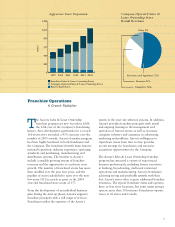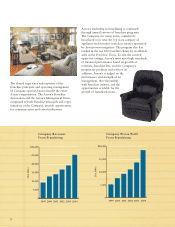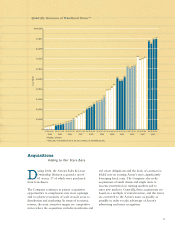Aarons 2004 Annual Report Download - page 19
Download and view the complete annual report
Please find page 19 of the 2004 Aarons annual report below. You can navigate through the pages in the report by either clicking on the pages listed below, or by using the keyword search tool below to find specific information within the annual report.
17
million in 2002, reflecting the net addition of 78 franchised
stores since the beginning of 2002 and improved operating
revenues at older franchised stores.
Cost of Sales
The 5.5% decrease in retail cost of sales is primarily a
result of a decrease in sales in our rent-to-rent division,
where sales decreased $3.9 million to $25.2 million in 2003
from $29.1 million in 2002, a 13.4% decline. This decrease
was primarily due to the decline in same store revenues and
to closing or merging under-performing stores. This decrease
is partially offset by a $1.0 million increase to $25.7 million
in 2003 from $24.7 million in 2002, representing a 3.9%
increase, in our sales and lease ownership division driven by
the increases in same store revenues and additional store
openings described above. Retail cost of sales as a percentage
of retail sales remained comparable between 2003 and 2002.
Cost of sales from non-retail sales increased 35.6%,
primarily due to the growth of our franchise operations as
described above, corresponding to the similar increase in
non-retail sales. As a percentage of non-retail sales, non-retail
cost of sales increased slightly to 92.8% in 2003 as compared
to 92.6% in 2002, primarily due to changes in product mix.
Expenses
The 17.6% increase in 2003 operating expenses was driven
by the growth of our sales and lease ownership division
described above. As a percentage of total revenues, operating
expenses improved to 45.0% for 2003 from 45.8% for 2002,
with the decrease driven by the maturing of new Company-
operated sales and lease ownership stores added over the past
several years and a 10.1% increase in same store revenues.
The 20.3% increase in depreciation of rental merchandise
was driven by the growth of our sales and lease ownership
division described above. As a percentage of total rentals and
fees, depreciation of rental merchandise decreased slightly to
35.3% in 2003 from 35.4% in 2002. The decrease as a per-
centage of rentals and fees reflects an improvement in rental
margins, partially offset by increased depreciation expense as
a result of a larger number of short-term leases in 2003.
The increase in interest expense as a percentage of total
revenues was primarily due to a higher long-term average
debt balance during 2003 arising from the Company’s
August 2002 private debt placement.
The 32.1% increase in income tax expense between years
was driven primarily by a comparable increase in pretax
income, offset by a slightly lower effective tax rate of 37.0%
in 2003 compared to 37.1% in 2002.
Net Earnings
The 32.7% increase in net earnings was primarily due
to the maturing of new Company-operated sales and lease
ownership stores added over the past several years; a 10.1%
increase in same store revenues; and a 16.5% increase in
franchise fees, royalty income, and other related franchise
income. As a percentage of total revenues, net earnings
improved to 4.8% in 2003 from 4.3% in 2002.
Balance Sheet
Cash. In prior balance sheet and statement of cash
flow presentations, checks outstanding were classified as a
reduction to cash. Since the financial institutions with checks
outstanding and those with deposits on hand did not and do
not have legal right of offset, we have reclassified checks out-
standing in certain zero balance bank accounts to accounts
payable at December 31, 2004 and for all consolidated
balance sheets and consolidated statements of cash flows
presented. This reclassification has the effect of increasing
both cash and accounts payable and accrued expenses by
$4.6 million, $3.8 million, and $6.7 million for the years
ended December 31, 2003, 2002, and 2001, respectively.
Rental Merchandise. The increase of $82.6 million in
rental merchandise, net of accumulated depreciation, to
$425.6 million from $343.0 million at December 31, 2004
and 2003, respectively, is primarily the result of a net
increase of 116 Company-operated sales and lease ownership
stores and two fulfillment centers since December 31, 2003.
Prepaid Expenses and Other Assets. The increase of
$23.9 million in prepaid expenses and other assets to
$50.1 million from $26.2 million at December 31, 2004
and 2003, respectively, is primarily the result of recording
an income tax receivable of $20.0 million, in connection with
calculating the Company’s 2004 provision for income taxes.
Goodwill and Other Intangibles. The increase of $19.4
million to $74.9 million from $55.5 million on December 31,
2004 and 2003, respectively, is the result of a series of acqui-
sitions of sales and lease ownership businesses, net
of amortization of certain finite-life intangible assets. The
aggregate purchase price for these asset acquisitions in
2004 totaled approximately $38.5 million, and the principal
tangible assets acquired consisted of rental merchandise
and certain fixtures and equipment.
Deferred Income Taxes Payable. The increase of $39.9
million in deferred income taxes payable at December 31,
2004 from December 31, 2003 is primarily the result of
March 2002 tax law changes, effective September 2001,
that allowed additional accelerated depreciation of rental
merchandise for tax purposes. Additional tax law changes
effective May 2003 increased the allowable acceleration and
extended the life of the March 2002 changes to December
31, 2004.
Credit Facilities. The $37.1 million increase in the
amounts we owe under our credit facilities to $116.7
million from $79.6 million on December 31, 2004 and 2003,
respectively, reflects net borrowings under our revolving
credit facility during 2004, primarily to fund purchases of
rental merchandise, acquisitions, and working capital. Also
contributing to the increase is a new capital lease with a
related party with an outstanding balance of $6.7 million
as of December 31, 2004.
Liquidity and Capital Resources
General
Cash flows from operating activities for the years ended
December 31, 2004 and 2003 were $34.7 million and
$68.5 million, respectively. Our cash flows include profits on
the sale of rental return merchandise. Our primary capital
requirements consist of buying rental merchandise for both
Company-operated sales and lease ownership and rent-to-
rent stores. In 2005, we anticipate that we will make cash
payments for income taxes approximating $58 million. As
Aaron Rents continues to grow, the need for additional rental
merchandise will continue to be our major capital require-
ment. These capital requirements historically have been
financed through:
• cash flow from operations
• bank credit
• trade credit with vendors
























